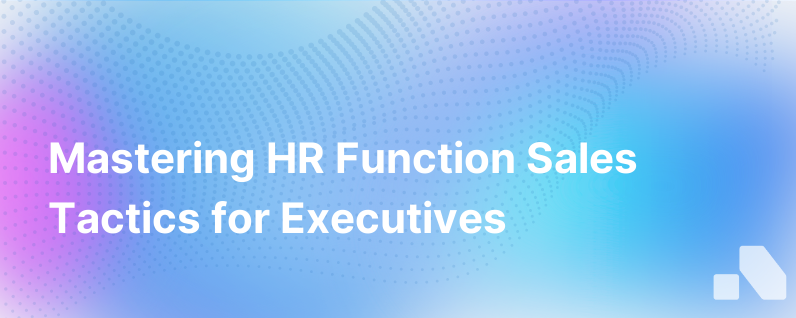
Selling to the HR function presents unique challenges and opportunities. Human Resources professionals are tasked with a significant responsibility – managing a company's most valuable asset: its people. Your solution needs to demonstrate tangible benefits not just to the HR team, but to the entire organization in terms of talent acquisition, retention, employee satisfaction, compliance, and more.
Understanding the nuances of selling to HR is crucial. HR buyers are varied – from CHROs (Chief Human Resources Officers) overseeing strategic workforce initiatives, to specialists in recruitment, learning and development, payroll, or employee relations. Each segment within HR has distinct priorities and measurements of success. Your approach needs to be tailored accordingly.
In this article, we will go in-depth into the strategies and best practices for effectively selling to HR functions. Get ready to enhance your understanding of the HR domain and refine your sales techniques for this critical audience.
Understanding the HR Function Landscape
Know Your Buyer Persona: HR is not a monolithic department. Titles such as HR Director, Talent Acquisition Manager, Learning and Development Lead, and Employee Relations Specialist represent different needs and challenges. Understanding these personas is key to crafting your value proposition.
Navigating Organizational Structures: In smaller companies, an HR department might consist of a few generalists, while larger organizations have specialized divisions. Your sales pitch should respect this structure – a one-size-fits-all approach rarely works.
Key Considerations When Selling To HR
Speak Their Language: Use terms that strike a chord with HR professionals – 'employee engagement,' 'talent pipeline,' 'workforce planning,' 'performance metrics,' 'employer branding,' and 'diversity and inclusion' are just some of the keywords that resonate with HR professionals.
Understand Regulations and Compliance: Be aware of specifics like GDPR, HIPAA, EEOC, and other compliance mandates as they heavily influence HR decision-making.
Demonstrate ROI: HR teams are under increased pressure to show how their initiatives contribute to the bottom line. Your solution should clearly outline the ROI in terms of time saved, increased productivity, reduced turnover, or improved employee engagement.
Crafting Your Sales Strategy
Educational Content: Position your brand as a thought leader. Create content around HR trends, best practices, and case studies to engage HR professionals and demonstrate expertise.
A Consultative Approach: Use data and insights to focus on solving problems rather than pushing a product. Consultative selling builds long-term relationships and is particularly effective in the HR space.
Personalized Demos: Tailor your product demonstrations to reflect the specific contexts and scenarios that the HR professional would recognize and relate to.
Build a Strong Business Case: Given that HR initiatives often require buy-in from other departments, your solution must come with a compelling business case that can persuade not just HR, but finance, operations, and other stakeholders.
Leaning on Testimonials and Case Studies: Share stories and data from current clients to validate your claims. Social proof is a powerful tool, especially when it comes from credible and relatable sources.
Approaches That Resonate with HR Buyers
Offering Tailored Solutions: HR is focused on creating customized approaches to employee management. Your solution should be adaptable to various company cultures and structures.
Focus on User Experience: HR is the champion of employee experience. If your product enhances this aspect, emphasize its user-friendly design, intuitive interfaces, and customer support.
Highlighting Compliance and Security: Stress how your solution stays abreast of compliance updates and takes security seriously. This is paramount in HR tech with so much sensitive employee data involved.
Promoting Efficiency and Automation: Illustrate how your tool saves time and reduces manual workload, freeing HR professionals to focus on strategic tasks.
Navigating the Sales Cycle
Understand the Buying Process: HR purchase decisions may involve several stages and stakeholders. Knowing each stage of the journey – from awareness to consideration to decision – is essential for timely and relevant follow-ups.
Offer Trials and Evaluations: HR professionals appreciate the chance to 'test drive' solutions. Be open to offering free trials or pilot programs, giving them a firsthand experience of your product.
Patience and Perseverance: The HR sales cycle can be lengthy due to budget cycles and complexity of decisions. Consistent touchpoints and nurturing over time are key to staying top-of-mind.
Partnerships and Alliances: Collaborating with organizations like SHRM (Society for Human Resource Management) can help in gaining credibility within the industry.
Conclusion
Selling to HR is as much about understanding human dynamics as it is about product excellence. Adept sales professionals recognize that engaging with HR buyers is about more than closing a deal; it's about fostering relationships and providing genuine solutions that contribute to the well-being and success of their workforce.
By approaching HR professionals with a consultative, empathetic, and knowledgeable strategy, and by tailoring solutions to HR-specific needs, vendors can establish meaningful connections, prove value, and ultimately, become essential partners in the modern workplace.
Remember, when you're selling to HR, you're selling a promise – the promise of efficiency, data-driven decision-making, and a happier workforce. Keep this in mind and let that promise be reflected in every aspect of your pitch and product. Finally, for an edge in real-time research and competitive intelligence for your tailored sales content, look to sophisticated tools like Aomni that provide the necessary insights and support for selling effectively to the HR function.